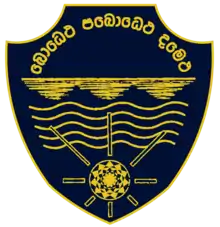Piliyandala Central College
Piliyandala Central College (Sinhala: පිලියන්දල මධ්ය මහා විද්යාලය; Tamil: பிலியன்தல மத்திய வித்தியாலயம்) is a selective entry mixed-gender school located in Piliyandala, Sri Lanka. It was the first government-run mixed-gender secondary school in the country.[1]

| Central College Piliyandala පිලියන්දල මධ්ය මහා විද්යාලය பிலியன்தல மத்திய வித்தியாலயம் | |
|---|---|
 | |
| Location | |
| Coordinates | 6°47′59″N 79°55′15″E |
| Information | |
| Other names | PCC |
| Type | National |
| Motto | Bodetha pabodetha dametha "බොධෙථ පබොධෙථ දමෙථ " Awareness Enlightenment Discipline |
| Established | 1887 (135 years ago) |
| Founder | Mampe Saranapala Thero |
| Principal | D. P. Udawaththage |
| Staff | 200+ |
| Grades | Class 6 - 13 |
| Gender | Mix |
| Age | 11 to 19 |
| Enrollment | 4000 |
| Language | Sinhala, English |
| Colour(s) | Dark blue, gold and maroon |
| Song | සිරිබර මැදි විදුහල් මාතා ("Beautiful Mother Central College") |
| Affiliation | Buddhism |
| Former pupils | Old Centralions |
| Website | www |
The school has an enrollment of around 3,700 students. Students of the college are known as Centralions and past pupils are known as Old Centralions.
History
.jpg.webp)
The school was first established in 1887 as the Mampe Piyarathanasara Buddhist Mix School, one of the first Buddhist schools in Sri Lanka. As the school grew in size, Rev. Mampe Saranapala Thero handed over the school to the Buddhist Theosophical Society for better administration. The society bought new land for the school but due to the rapid increase in the number of students, was unable to maintain it, and so eventually handed it over to the government.
In 1920, as a part of a program of the British agent of western province Mr Praiser, Piliyandala got a Public English Medium Mix School. The headmaster of this school was S. W. Sahabandu, and the two schools (the public English medium mix school and the Sinhalese medium mix school) were divided by a building that was shaped like a bird.
From 1920 to 1944, C. W. W. Kannangara reunited both schools and together formed Piliyandala Central College on 4 January 1944, which later on 4 March that year was converted into a Central College.
Administration
The college is funded by the Ministry of Education, which also appoints its principal. The principal is the head of the administration of the college and is assisted by the deputy principal. The college is divided into two main parts, which are the middle and high schools, each coming under the supervision of the assistant principals. The college educates around 3,700 students.
Since its establishment, the main language of education had been Sinhalese. In 2009, English was introduced as an optional language of education for the main subjects at the college. Students may select one of the two languages in which to conduct their studies in the main subjects.
Admission
Admission to the college is among the most competitive outside the Colombo city area in the Colombo district.[2] It gets its highest number of applications for admission to grade 6 via the grade 5 scholarship examination. A number of students from all over the area are also entered to grade 12 via the G.C.E. Ordinary Level examination.
Campus

The school is mostly located in Piliyandala but also spreads towards Suwariyapola, occupying a total land area of about 48,000 m2 (520,000 sq ft). The facilities include lecture halls, science and ICT laboratories, an auditorium, a swimming pool complex and a cricket ground.
Sports
Sport plays a significant part in college life. An annual cricket match between Central College Piliyandala and sporting rivals Taxila Central College, Horana, known as the Battle of the Salpiti-Raigam, has been held since 2001.
Houses
Each student is assigned to one of four houses named after ancient Sinhala kings of Sri Lanka: Gemunu, Wijaya, Parakrama and Thissa.

References
- edu.lk "About Us". Piliyandala Central College. Retrieved 15 July 2015.
{{cite web}}: Check|url=value (help) - "Cutoff Marks for the Admission to Grade 6 in Popular Schools".